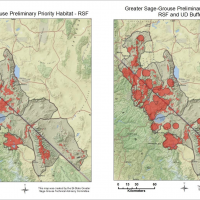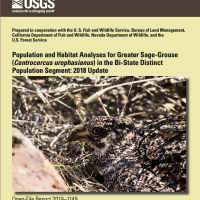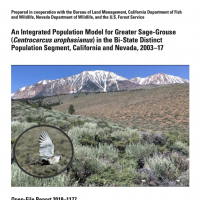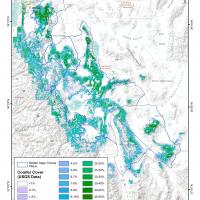Habitat models are important tools in identifying key areas utilized by Bi-State sage-grouse based on habitat characteristics, telemetry locations and vital rate data. The Bi-State sage-grouse habitat map is based on two well-accepted modeling approaches: resources selection functions (RSFs) and utilization distributions (UDs). RSFs and UDs were used to identify areas important to these populations based on associations with certain environmental characteristics and space use by sage-grouse respectively.
- Conservation
- Bi-State Area Information
- Bi-State Action Plan
- Annual Accomplishment Reports
- Land Conservation and Sustainable Agriculture
- Latest News
- News Links
- Hiring Bi-State Sage-Grouse Communication and Data Coordinator
- Integrated Population Models: Understanding Population Dynamics and Informing Conservation Actions
- LADWP Notice of Preparation of a Draft EIR
- NRCS Partners Seek to Assist Bi-State Sage-Grouse Area Ranchers With Conservation Through Partnership Project
- Sage-Grouse: A Life Cycle In Photos
- Bi-State Coordinator Hired to Support Local Area Working Group
- Celebrating Conservation: Partners Protect the Bi-State Sage-Grouse
- POSTPONED: Traditional Ecological Summit: June 3-4, 2020
- Bi-State Sage Grouse Coordinator Job Opening
- Community Based Capacity-Partners in the Sage
- Bishop Students participate in Writing Contest
- Bi-State Sage Grouse Work Days in Green Creek
- It Takes a Community to Save an Ecosystem
- Bi-State Partnership on the California-Nevada Border
- Finding Common Ground: Western Science Meets Indigenous Knowledge at Sage Grouse Summit
- Bi-State Local Area Working Group collaborates with new Nevada state park to balance people and wildlife
- Bi-State Sage-Grouse Get a New Home on Earth Day: Translocation of select birds seeks to improve imperiled sub-population
- Videos
- Photographs
- News Links
- Science
- Coordination
- Contact




